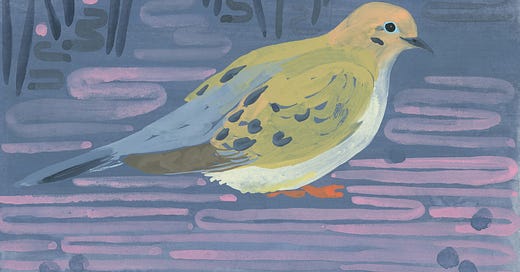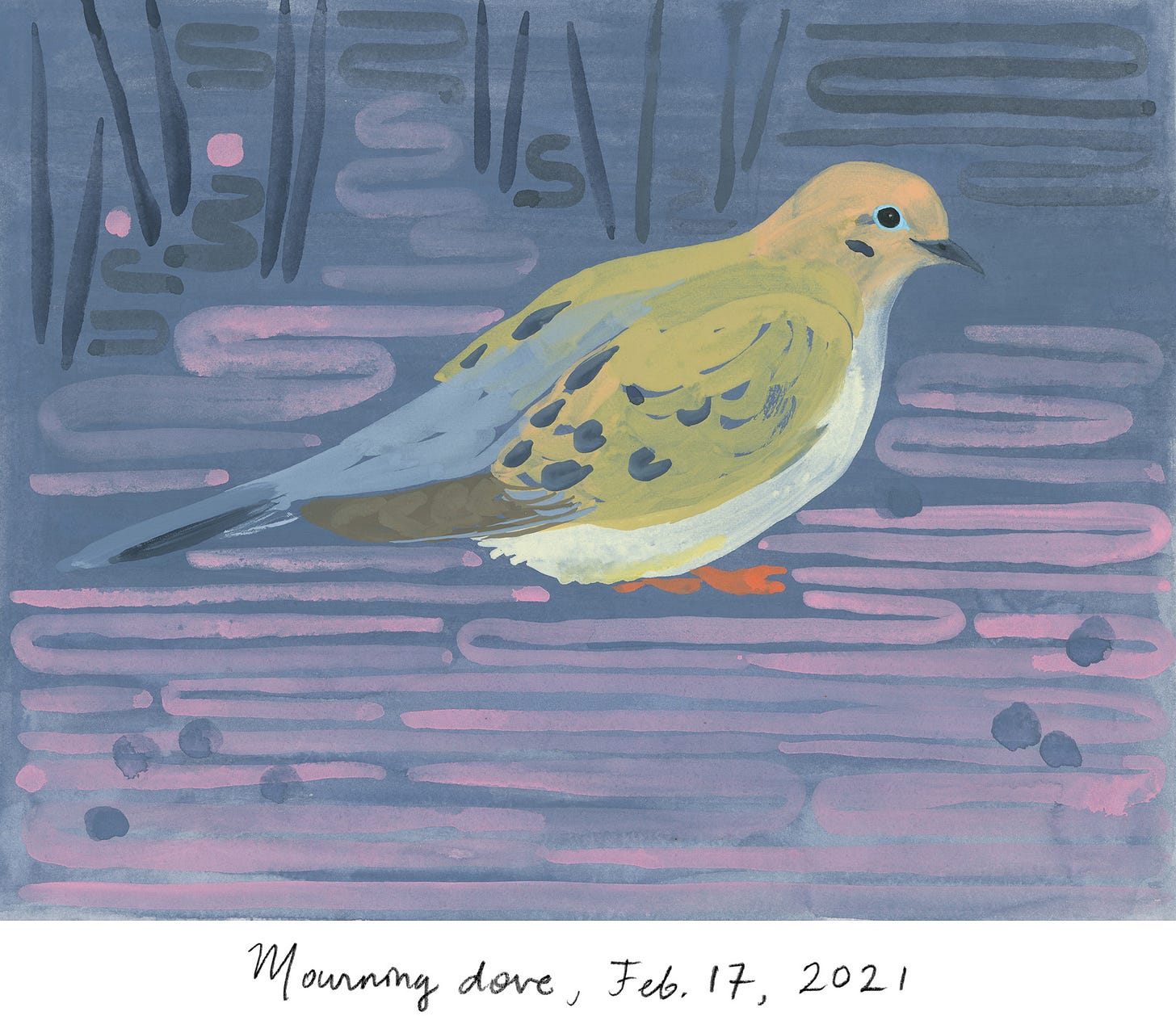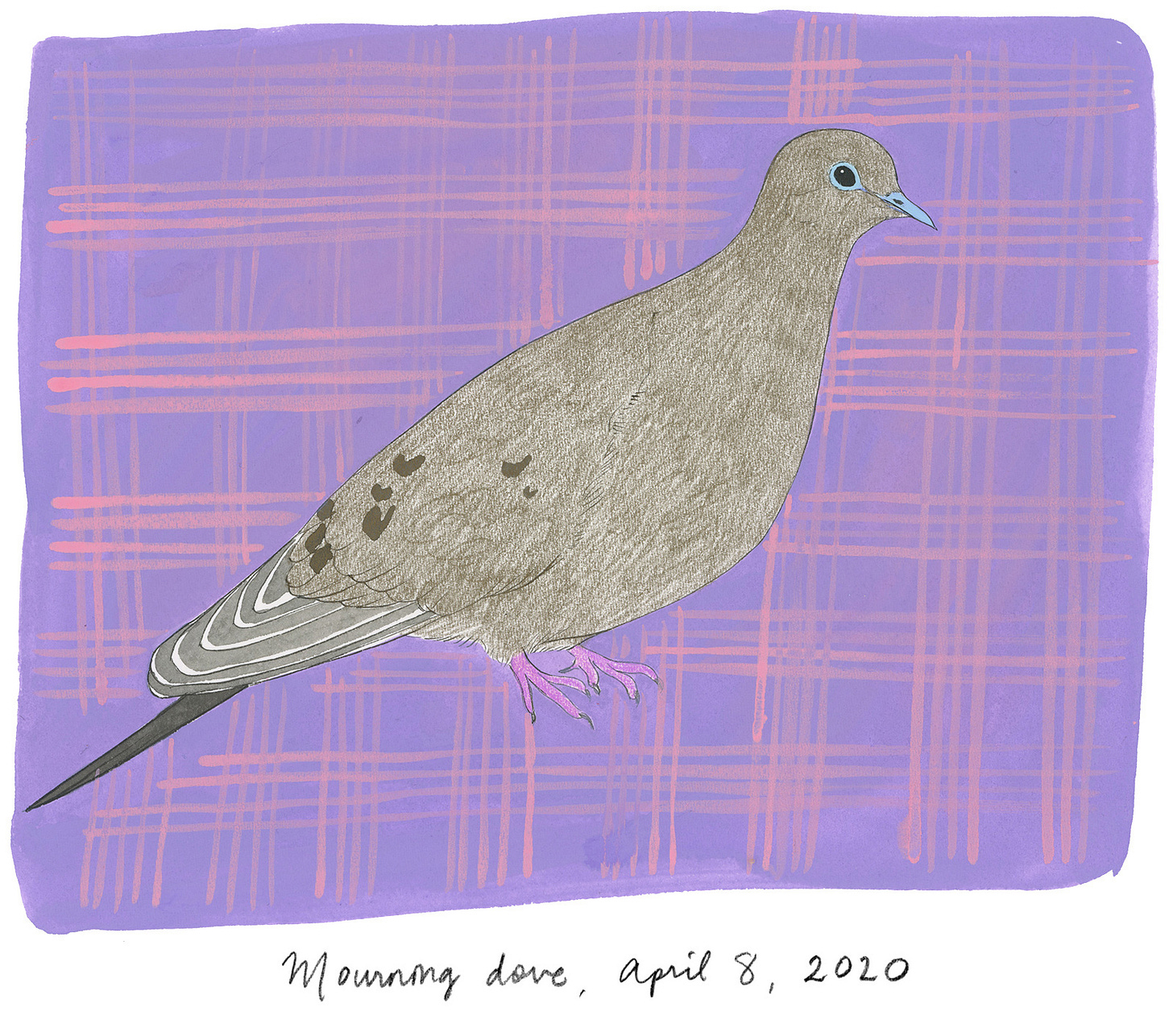Hi, friends — welcome to issue #14 of my newsletter about animal encounters. It’s cold and icy out but the little doves (Zenaida macroura) keep popping up. As always, please add your small stories to the comments, or you can reply directly to this email. Thanks! — AJP
The mourning dove is one of those creatures that appears—in the snow, in a tree, out the window, in the sun, around the corner, on the ground, along the road. Their muted tones have a soothing effect, softening the edges and blending into the backdrop.
This week, on a short walk with the kids and dog, we heard the distinctive trill of a mourning dove’s wing feathers as he flew from the ground to a branch of a birch tree. He caught the sunlight and we could see him easily, the little blue ring around his eye perfectly matching the sky.
I don’t see them always, but I do see them often. One spring morning last year, I saw a mourning dove out of every window. (Was it déjà vu or was it a dove?) There’s a regular little flock of them that shuffles along the road on the way to school each morning. I haven’t figured out what is special about that bit of road (maybe just the morning sun), but at least I know to slow down before they burst into flight.
Mourning doves are native to North America and widespread across the continent. Though I know them well in Connecticut, I actually associate them most with my adolescent years in Arizona—their cooing reminds me of the desert. (Literally nothing else in Connecticut reminds me of the desert.) Their soft, sad cooing has a strong undertow, and is the reason for the “mourning” in their name, though they are also known as rain doves and turtle doves (not quite those turtle doves, but similar).
Mourning doves survive northern winters in part due to bird feeders; they have adapted to human neighborhoods and cities quite well. Unlike many creatures, the expansion of European settlers in the 1800s likely benefitted them, as spaces were opened up. They eat all manner of seeds (making up 99% of their diet), foraging mainly on the ground. Most populations will migrate to warmer regions in the fall, but if they stay (mainly males), they roost together at night for warmth.
In spring, males court females with their whistle-y flight and a routine of bobbing and calling. Female doves build the nest—which is a sloppy affair compared to many birds’ nests. She throws together whatever the male brings and calls it a day. (The thought of it makes me laugh.) The pair takes turns at the nest, keeping the clutch of two eggs warm. Once hatched, both parents care for the young squabs, feeding them pigeon’s milk (a protein-rich secretion made in the crop) for the first few days.
Mourning dove pairs are monogamous and form strong bonds, mating for life. In warmer climes, they can raise up to six broods a year, managing to stay ahead of the predation curve (mortality is extremely high for these gentle birds). They are a popular game bird, and their numbers are generally monitored for hunting. While their population is strong overall, there has been some decline in recent years.
Look out your window just about anywhere in the United States and you might see one now. Listen and you might hear their soft lament, reminding you of your youth, connecting you across time and geography. I find their gentle presence softens the hard frost of day.
Mourning dove links—
Listen to their “wing whistle” — you will likely recognize it, even if you didn’t realize it before — plus their familiar cooing. [Cornell Lab of Ornithology]
This sweet photo of an adult with two squabs in the cactus made my February heart melt a little. [Wikipedia]
Males have a small patch of iridescent pink feathers on their neck. I find their palette of taupe-y browns and grays insanely beautiful (the desert girl in me is strong). [beautiful image at Audubon]
As ground feeders, mourning doves are particularly susceptible to house cat predation (keep your cuties indoors, or in those cool “catios”). [some info at American Bird Conservancy]
Animal encounters in recent comments—
Thank you for your dark-eyed junco stories—there are a few out right now in the middle of the falling snow.
Also—
Here’s a beautiful project: “Lost Soundscapes: Iron Age Somerset” by ornithologist Joseph Monkhouse, composed of 73 layered birdsongs, and featured in Inkcap, a terrific newsletter and resource on ecology and conservation in the UK by Sophie Yeo. [Inkcap]
I’m debating barred owls or gray squirrels for next week; or, please let me know your suggestions.
Little dovie is for sale; please let me know if you’re interested. I’ll send some of the proceeds to The Cornell Lab of Ornithology.
Thanks for reading and I hope this brings some cheer as winter hits hard. This newsletter is a small weekly adventure about the life around us—please share with friends and family who would enjoy.






Meant to say the roadrunner killed a mourning dove.
I vote Barred Owl, but I know I have talked about them before. Also on an pretty off topic note but I don't know where else to share this, so driving home last night a bunch of cars were slowing down because a falcon was flying at like car height and passing us on the side of the road, it was so cool. And I saw what I assume is the same falcon in a similar spot today.